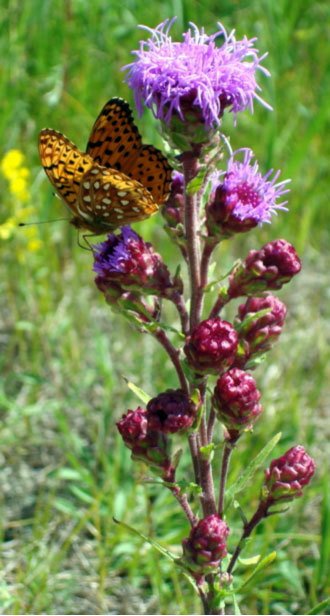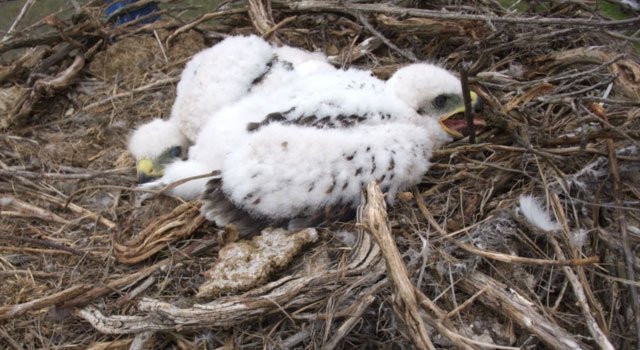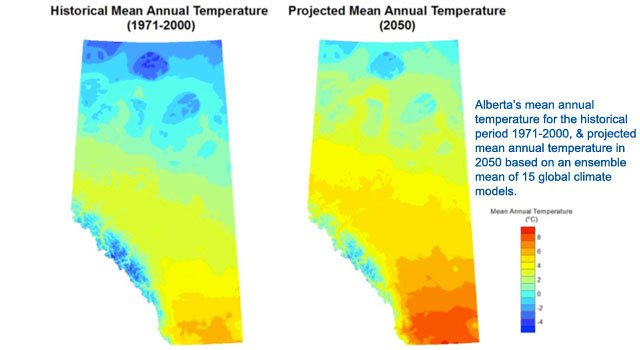June 20, 2013. Extreme rainfall in parts of southern Alberta triggers catastrophic flooding – the worst in this province’s history. The toll: four dead, thousands without a place to live, and recovery costs in the billions. With insurance payments in Canada doubling every 5-10 years since 1980 due to severe weather events like this one, the reality is Canada’s – and Alberta’s – climate is changing.

The Northern Blazing Star (Liatris ligulistylis) is a rare plant with a range in Alberta that is restricted to the centre of the province. Researchers on the BMCCA project, Dr. Scott Nielsen and Jennine Pedersen, are testing the fitness (survival and reproductive success) of this species when it is planted outside its current range. These experiments will help inform whether transplanting individuals of this species to new locations (called “managed relocation” or “assisted migration”) could be a useful adaptation strategy to conserve this species in Alberta as climate changes. Photo credit: Scott Nielsen.
Climate change and its impact on local weather patterns not only affect people and their activities; it also has consequences for our natural world. Under climate change, familiar species like the Canadian Toad may suffer as the environments they depend on for survival become drier and hotter. On the other hand, species such as the White-tailed Deer may benefit from these changes. Similarly, natural regions like Alberta’s grasslands are also susceptible to climate change; temperature and moisture determine when and where these regions exist.
Clearly, the potential implications of climate change on the wild Alberta we know today are far-reaching. As a result, there’s a clarion call for natural resource managers – from government officials to industrial land managers – to develop adaptation strategies to ensure the sustainability of our shared natural heritage in the context of an increasingly unpredictable climate. Adaptation strategies focus on planning for potential climate change and complement ongoing mitigation efforts to find creative solutions to reduce greenhouse gas emissions.
The Alberta Biodiversity Monitoring Institute (ABMI) is spearheading a highly collaborative endeavour called the Biodiversity Management and Climate Change Adaptation (BMCCA) project. The project is addressing what climate change means for the future of Alberta’s natural world, and how best to respond.
“What we’re creating with the BMCCA project is the capacity for Alberta to adapt to climate change and we’re using a three-pronged approach to achieve this – knowledge, tools, and policy evaluation,” says Dr. Dan Farr, Director of ABMI’s Application Centre, the arm of the ABMI that demonstrates the use of ABMI data to tackle specific land-use or resource management challenges.
The BMCCA project is broken into three main areas of focus: 1. The impact of climate change on Alberta’s species; 2. The impact of climate change on Alberta’s natural regions; and, 3. How these impacts, in turn, affect the long-term resilience of Alberta’s communities to climate change. Each of these areas of focus is approached using the framework of “knowledge, tools and policy evaluation.” For example, in the case of species, researchers are generating the fundamental knowledge of the vulnerability of Alberta’s species to climate change; they’re creating and testing tools to aid the adaptation of particular species to projected future environmental conditions; and they’re identifying potential policy options that would support the management of Alberta’s species under a changing climate.
The project, now in its second year, is being coordinated by ABMI’s Amy Nixon. “In relation to the ‘species’ area of focus, we’re working on assessing the climate change vulnerability of more than 150 Alberta species, from vascular plants, to amphibians, to winter mammals,” explains Nixon.
“In these assessments, we’re identifying species that may be exposed to large changes in temperature or moisture within their current range. These are the species”, says Nixon, “likely to be most vulnerable to climate change and that may need extra attention if Albertans want to them to persist in the province over the long-term. Our final report is anticipated this winter.”
“We’re also drilling down to determine the potential future distributions of many of Alberta’s species as they shift in response to climate change,” she adds. “We’ve been focusing our modelling and mapping efforts on Alberta’s song birds and rare plants. The maps we’re producing will describe where – or whether! – a particular species is likely to persist in Alberta in our future climate.”
Other BMCCA project members are conducting fieldwork to directly test how certain species are responding to a changing environment, and Nixon explains what they’re finding.

Ferruginous Hawk (Buteo regalis) chicks are vulnerable to extreme weather events in the prairies, which are projected to increase with climate change in Alberta. BMCCA researchers are testing whether artificial nest structures could lessen the negative effects of high winds on the nesting success of these birds.
“We’ve identified extreme rainfall as a key driver in the nesting success of Burrowing Owls. We’ve also launched two additional field programs: one examines the consequences of extreme weather on Ferruginous Hawks and the other asks how the survival and reproduction of a plant species, such as the Northern Blazing Star, is affected when planted outside its current climate conditions.”
In relation to the BMCCA project’s second area of focus, ABMI scientist Dr. Richard Schneider has just released a cutting edge report called “Alberta’s Natural Subregions Under a Changing Climate: Past, Present, and Future.” This report describes how Alberta’s natural regions have responded to climate change in the past and how they are expected to change over the next hundred years. With many of Alberta’s natural regions predicted to shift northward (see accompanying blog for details), the next phase of this work will look at the implications of potential drastic change on our landscapes.
With Alberta’s species and natural regions under threat from climate change, Alberta communities that rely on these natural systems for their survival and well-being will also keenly feel the effects. To this end, the BMCCA project is working to identify “biodiversity-friendly” adaptation actions that promote climate resiliency in communities where Albertans live and work. These actions could include things like enhancing or restoring natural wetlands to promote water storage in drought years – a “win-win” action for human communities and for biodiversity. Check out upcoming blogs for more on this work.
So, at the conclusion of this vast and varied project, what outcomes would the BMCCA team like to see?
“We’d love to see decision makers adopting our projects’ outcomes”, says Dan Farr from ABMI’s Application Centre. “And by decision makers I mean governments, private industry, non-governmental organizations and individual citizens. That would be a home run for us – the adoption of our outcomes”
The BMCCA project involves biodiversity scientists and policy analysts from the University of Alberta, Miistakis Institute, Alberta Innovates Technology Futures, and the Government of Alberta. The funding for this work comes primarily from the Climate Change and Emissions Management (CCEMC) Corporation.
To learn more, view data, or stay up to date on the BMCCA project, its reports, and other information, visit http://www.biodiversityandclimate.abmi.ca/

